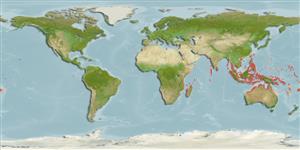>
Kurtiformes (Nurseryfishes, cardinalfishes.) >
Apogonidae (Cardinalfishes) > Apogoninae
Etymology: Fibramia: Latin 'fibra' meaning thread or filament and the feminine Greek 'amia' often applied as an ending for some cardinalfish genera as well as an incorrect past usage as a cardinalfish genus. The name refers to two characteristics of the species in this genus, an elongate second dorsal spine in one species and the narrow, pale or dark mid-line on the body of two species.
More on author: Valenciennes.
Issue
Generic placement confirmed by T. Fraser (pers.comm. 06/2011).
Environment: milieu / climate zone / rango de profundidad / distribution range
Ecología
marino; agua dulce; salobre asociado a arrecife; no migratorio (Ref. 59012); rango de profundidad 0 - 3 m (Ref. 86942). Tropical; 26°N - 25°S, 32°E - 172°E
Indo-Pacific: East Africa to Tonga, north to Japan; Mariana and Caroline islands in Micronesia; south to Lord Howe Island (Ref. 9710).
Tamaño / Peso / Age
Madurez: Lm ? range ? - ? cm
Max length : 11.0 cm TL macho / no sexado; (Ref. 9710)
Short description
Claves de identificación | Morfología | Morfometría
Espinas dorsales (total) : 7; Radios blandos dorsales (total) : 9; Espinas anales: 2; Radios blandos anales: 8.
Body shape (shape guide): short and / or deep; Cross section: compressed.
A euryhaline species (Ref. 59012), often found in freshwater and estuaries (Ref. 4329), shallow sheltered inshore reefs or river mouths, among clumps of algae or algal covered rubble. Found in aggregations (Ref. 9710).
Life cycle and mating behavior
Madurez | Reproducción | Puesta | Huevos | Fecundidad | Larva
Mouthbrooders (Ref. 240). Distinct pairing during courtship and spawning (Ref. 205).
Mabuchi, K., T.H. Fraser, H. Song, Y. Azuma and M. Nishida, 2014. Revision of the systematics of the cardinalfishes (Percomorpha: Apogonidae) based on molecular analyses and comparative reevaluation of morphological characters. Zootaxa 3846(2):151-203. (Ref. 96888)
IUCN Red List Status (Ref. 130435: Version 2025-1)
Threat to humans
Harmless
Human uses
Herramientas
Special reports
Download XML
Fuentes de Internet
Estimates based on models
Preferred temperature (Referencia
123201): 25.6 - 29.3, mean 28.6 °C (based on 2233 cells).
Phylogenetic diversity index (Referencia
82804): PD
50 = 0.6250 [Uniqueness, from 0.5 = low to 2.0 = high].
Bayesian length-weight: a=0.01230 (0.00742 - 0.02039), b=3.02 (2.88 - 3.16), in cm total length, based on LWR estimates for this species & (Sub)family-body (Ref.
93245).
Nivel trófico (Referencia
69278): 4.0 ±0.60 se; based on food items.
Resiliencia (Referencia
120179): Alto, población duplicada en un tiempo mínimo inferior a 15 meses (Preliminary K or Fecundity.).
Fishing Vulnerability (Ref.
59153): Low vulnerability (10 of 100).
🛈
Nutrients (Ref.
124155): Calcium = 141 [68, 265] mg/100g; Iron = 0.898 [0.473, 1.699] mg/100g; Protein = 19.2 [18.0, 20.4] %; Omega3 = 0.118 [0.061, 0.232] g/100g; Selenium = 17.7 [7.6, 39.5] μg/100g; VitaminA = 64.4 [17.1, 248.3] μg/100g; Zinc = 1.83 [1.11, 2.85] mg/100g (wet weight);
